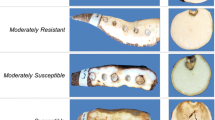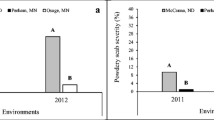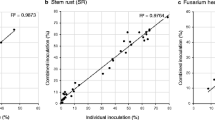Abstract
Cassava root rot disease (CRRD) severely affects productivity in several countries. The objective of this study was to estimate genetic parameters and to identify multiple resistance sources against pathogens associated with CRRD. The symptoms caused by Fusarium spp., Phytophthora spp., and Botryosphaeriaceae species in peel and pulp from the roots were evaluated in 277 accessions using a whole tuberous root inoculation method. The resistance data were obtained by REML/BLUP (restricted maximum likelihood/best linear unbiased predictor). The classic selection index (CI), multiplicative (MI), and sum of ranks (SRI) were used to identify the accessions with multiple resistance. For all pathogens, the environmental variance (\(\sigma_{e}^{2}\)) was the most important component. Individual heritability \(\left( {h_{g}^{2} } \right)\) was of low magnitude for resistance to most pathogens (0.16 ± 0.02—peel and 0.31 ± 0.03—pulp for Fusarium spp.; 0.26 ± 0.03—peel and 0.30 ± 0.03—pulp for Phytophthora spp.; and 0.28 ± 0.03—peel and 0.27 ± 0.03—pulp for Botryosphaereacea species). The distribution of CRRD symptoms indicated the presence of quantitative inheritance. The direct selection of the 15 more resistant accessions based on the genotypic predicted values result in high reductions of disease (>50%). However, there was a low matching rate of the most resistant accessions for each pathogen and the different parts of the tuberous roots (peel and pulp). The CI and MI were the most promising compared to the SRI to ensure high and balanced resistance for each pathogen. Understanding the genetic basis of resistance to CRRD and the identification of sources with multiple resistance may be useful in various management strategies to control the disease.
Similar content being viewed by others
References
Aina OO, Dixon AGO, Akinrinde EA (2007) Genetic variability in cassava as it influences storage root yield in Nigeria. J Biol Sci 7:765–770
Alvarez E, Loke J, Rivera S, Llano G (2002) Genética de la resistencia a pudrición causada por Phytophthora tropicalis en dos poblaciones segregantes de yuca (Manihot esculenta Crantz). Fitopatol Colomb 26:61–66
Ashkani S, Rafii MY, Rusli I, Sariah M, Abdullah SNA, Harun AR, Latif MA (2012) SSRs for marker-assisted selection for blast resistance in rice (Oryza sativa L.). Plant Mol Biol Rep 30:79–86
Bandyopadhyay R, Mwangi M, Aigbe SO, Leslie JF (2006) Fusarium species from the cassava root rot complex in West Africa. Phytopathology 96:673–676
Banito A, Kpémoua KE, Bissang B, Wydra K (2010) Assessment of cassava root and stem rots in ecozones of Togo and evaluation of the pathogen virulence. Pak J Bot 42:2059–2068
Borges V, Ferreira PV, Soares L, Santos GM, Santos AMM (2010) Seleção de clones de batata-doce pelo procedimento REML/BLUP. Acta Sci Agron 32:643–649
Falconer DS, Mackay TFC (1996) Introduction to quantitative genetics, 4th edn. Pearson Education Limited, London
FAO (2015) FAOSTAT database. FAO, Rome. http://faostat.fao.org/. Accessed 26 Jan 2015
Figueiredo UJ, Nunes JAR, Valle CB (2012) Estimation of genetic parameters and selection of Brachiaria humidicola progenies using a selection index. Crop Breed Appl Biotechnol 12:237–244
Fokunang CN, Akem CN, Dixon AGO, Ikotun T (2000) Evaluation of a cassava germplasm collection for reaction to three major diseases and the effect on yield. Genet Resour Crop Evol 47:63–71
Freitas ILJ, Amaral Junior AT, Viana AP, Pena GF, Cabral OS, Vittorazzi C, Silva TRC (2013) Ganho genético avaliado com índices de seleção e com REML/Blup em milho pipoca. Pesq Agropec Bras 48:1464–1471
Guo H, Li CP, Shi T, Fan CJ, Huang GX (2012) First report of Phytophthora palmivora causing root rot of cassava in China. Plant Dis 96:1072
Hillocks RJ (2014) Addressing the yield gap in Sub-Saharan Africa. Outlook Agric 43:85–90
Hoover H (2001) Composition, molecular structure, and physicochemical properties of tuber and root starches: a review. Carbohydr Polym 45:253–267
Jayasuriya KE (2004) Factors affecting disease tolerance of rubber tree and research needs for developing disease tolerant genotypes for the sustainability of rubber industry. Bull Rubber Inst Sri Lanka 45:1–10
Kiryowa M, Tukamuhabwa P, Adipala E (2008) Genetic analysis of resistance to soybean rust disease. Afr Crop Sci J 16:211–217
Llano GA, Álvarez E, Muñoz JE, Fregene M (2004) Identificación de genes análogos de resistencia a enfermedades en yuca (Manihot esculenta Crantz) y su relación con la resistencia a tres especies de Phytophthora. Acta Agron 53:15–24
Machado AR, Pinho DB, Oliveira SAS, Pereira OL (2014) New occurrences of Botryosphaeriaceae causing black root rot of cassava in Brazil. Trop Plant Pathol 39:464-470.
Msikita W, Bissang B, James BD, Baimey H, Wilkinson HT, Ahounou M, Fagbemisi R (2005) Prevalence and severity of Nattrassia mangiferae root and stem rot pathogen of cassava in Benin. Plant Dis 89:12–16
Okechukwu RU, Dixon AGO, Akoroda MO, Mwangi M, Bandyopadhyarr R (2009) Root rot resistance in new cassava varieties introduced to farmers in Nigeria. Exp Agric 45:15–24
Oliveira SAS, Hohenfeld CS, Santos VS, Haddad F, Oliveira EJ (2013) Resistance to Fusarium dry root rot disease in cassava accessions. Pesq Agropec Bras 48:1414–1417
Onyeka TJ, Dixon AGO, Ekpo EJA (2005a) Identification of levels of resistance to cassava root rot disease (Botryodiplodia theobromae) in African landraces and improved germplasm using in vitro inoculation method. Euphytica 145:281–288
Onyeka TJ, Dixon AGO, Ekpo EJA (2005b) Field evaluation of root rot disease and relationship between disease severity and yield in cassava. Exp Agric 41:357–363
Onyeka TJ, Dixon AGO, Ekpo EJA (2005c) Assessment of laboratory methods for evaluating cassava genotypes for resistance to root rot disease. Mycopathologia 159:461–467
Resende MDV (2002a) Genética biométrica e estatística no melhoramento de plantas perenes. Embrapa Informação Tecnológica, Brasília
Resende MDV (2007) Selegen-REML/BLUP: sistema estatístico e seleção genética computadorizada via modelos lineares mistos. Embrapa Florestas
Resende MDV, Duarte JB (2007) Precisão e controle da qualidade de experimentos para avaliação de cultivares. Pesq Agropec Trop 37:182–194
Rickard JE, Asaoke M, Blanshard JMV (1991) The physico-chemical properties of cassava starch. Trop Sci 31:189–207
Sornyotha S, Kyu KL, Ratanakhanokchai K (2007) Purification and detection of linamarin from cassava root cortex by high performance liquid chromatography. Food Chem 104:1750–1754
Souza LS, Farias AR, Mattos PLP, Fukuda WMG (2006) Aspectos socioeconômicos e agronômicos da mandioca. Embrapa Mandioca e Fruticultura Tropical, Cruz das Almas
Suppakul P, Chalernsook B, Ratisuthawat B, Prapasitthi S, Munchukangwan N (2013) Empirical modeling of moisture sorption characteristics and mechanical and barrier properties of cassava flour film and their relation to plasticizing-antiplasticizing effects. LWT Food Sci Technol 50:290–297
Viana JMS (2007) Breeding strategies for recurrent selection of maize. Pesq Agropec Bras 42:1383–1391
Vilas Boas SAV, Hohenfeld CS, Oliveira SAS, Santos VS, Oliveira EJ (2016) Sources of resistance to cassava root rot caused by Fusarium spp.: a genotypic approach. Euphytica 209:237–251
Vilas Boas SAV, Oliveira SAS, Bragança CAD, Ramos JB, Oliveira EJ (2017) Survey of fungi associated with cassava root rot from different producing regions in Brazil. Sci Agricola 74:60–67
Acknowledgements
The authors thank the Fapesb, CAPES and CNPq for the financial assistance and scholarship support.
Author information
Authors and Affiliations
Corresponding author
Rights and permissions
About this article
Cite this article
de Oliveira, E.J., de Oliveira, S.A.S., Boas, S.A.V. et al. Selection of cassava accessions with multiple resistance to pathogens associated with root rot disease. Euphytica 213, 185 (2017). https://doi.org/10.1007/s10681-017-1973-6
Received:
Accepted:
Published:
DOI: https://doi.org/10.1007/s10681-017-1973-6




